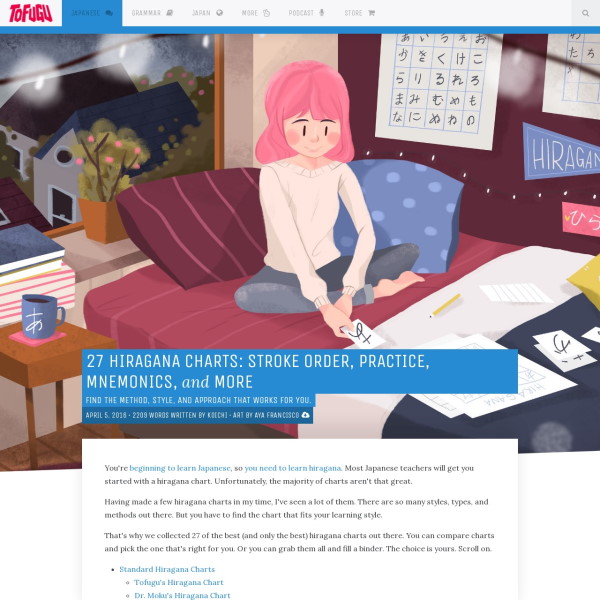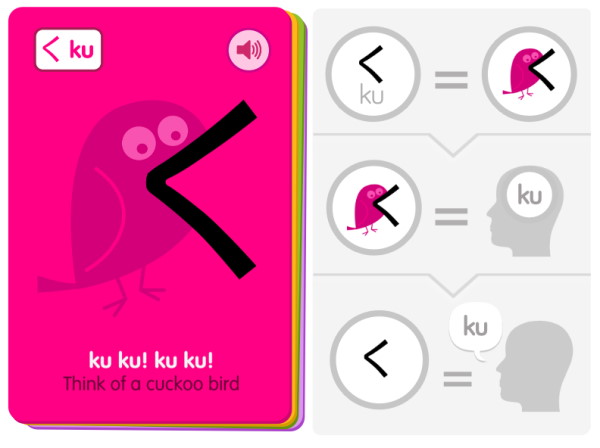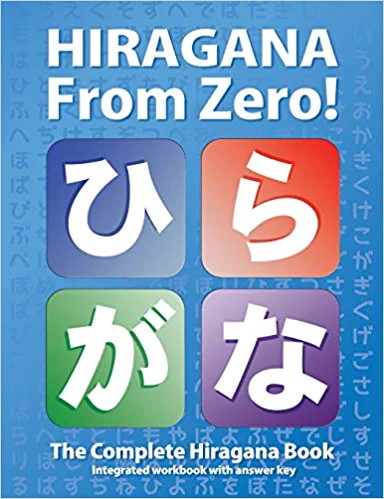Hiragana
ひ ら が な
What is Hiragana?
Hiragana is part of the Japanese writing system with 46 basic characters. It is a syllabary (phonetic alphabet) where each character represents a specific sound that is pronounced only one way. This contrasts with English where each letter can be pronounced in different ways depending on the word.
The word hiragana means ‘simple’. Its name is a comparison to the (Chinese derived characters) that Japanese was entirely written in before it’s development (and still largely is). Being the simplest, it’s most often the first of the four Japanese writing systems learned and considered the easiest.
There are no uppercase or lowercase in Japanese. わ (wa) is written as わ whether it is at the start of the sentence or a name.
Where did it originate?
Every hiragana character is based on a version of a traditional Chinese character (Hanzi), keeping the same sound but simplifying the character. For example, 加 (ka) became か. Notice how the left side is nearly identical but more rounded. Also, the right side is now to a single diagonal line rather than a box with legs.
Writing Direction
The writing direction in modern Japanese is usually horizontal rows left to right from top to bottom (known as yokogaki). This change was, in part, due to the influence of the United States during the Japanese occupation after World War 2.
Traditionally, the language was written in vertical columns right to left and from top to bottom (known as tategaki). This is still used. A well-known example is Manga (comics) with the boxes themselves being read in this direction as well as the text. You may also encounter tategaki with more ‘old-fashioned’ types of writing including literature, letters, and even greetings cards.
Sometimes you will even encounter media that is written in both ways on the same page. One prominent example of this is printed newspapers which do this to make optimal use of space.
Examples
Here are some examples using Japanese words you may already know.
す し
か た な
き も の
Should I Learn Hiragana?
As the Japanese script is different than the alphabet you are used to, you may be tempted to simply skip learning it. If you only ever want to learn to speak the language, you may be able to get away with only using Romaji (Romanised spellings). However, you will have to try extra hard to use the correct pronunciation and not just read as if it was in English.
But if you want to successfully learn to read Japanese, you shouldn’t avoid learning Hiragana (or any other script). Everything made for native speakers will use the scripts whether it is games, manga, or street signs.
Hiragana Chart
| a | i | u | e | o | |
|---|---|---|---|---|---|
| ∅ | あ | い | う | え | お |
| K | か | き | く | け | こ |
| S | さ | し | す | せ | そ |
| T | た | ち | つ | て | と | N | な | に | ぬ | ね | の |
When was it invented?
Japanese was first written in Chinese characters (Kanji) since about the year 100 A.D. By 350 A.D., they were used extensively throughout the entire country.
Although these characters suited their original language, they didn’t fit Japanese. By the year 794 A.D. (the start of the Heian period), a new set of Kanji had evolved that were used only for their phonetic value (the sound they made). Their original meaning of was abandoned.
Hiragana was developed naturally over time by simplifying this new subset of Kanji rather than being invented all at once on a specific day. The result was by the year 1185 A.D. (the end of the Heian period), they can (mostly) be recognised as the same Hiragana used to this day.
Today, around two thousand Kanji characters are still used with their original Chinese meanings alongside Hiragana and Katakana to form the extraordinary Japanese script.
What is the Difference Between Hiragana, Katakana and Kanji?
There are four parts of the Japanese writing system. They are Hiragana, Katakana, Kanji and Romaji.
- Kana – the two syllabaries, hiragana, and katakana, are known together as Kana
- Hiragana – rounded characters discussed on this page
- Katakana – straight characters used to represent the same sounds as Hiragana but are used for writing non-Japanese words (loanwords and names), emphasis (like bold or italics in English), onomatopoeia, and slang words.
- Kanji – detailed characters (ideographs) that represent an entire idea or object. They are derived from Chinese characters.
- Romaji – used to write Japanese in the Latin alphabet (the one English uses). This is how many people type into a computer and have software convert to the correct character. At the start of your learning journey, these may be used as a crutch until you understand Hiragana.
How to Learn
When first learning to write, Japanese kids begin by learning Hiragana. They then steadily progress to replacing the necessary words with Kanji, using Furigana to help them along the way. It stands to reason that if native speakers learn this way, you should too.
The best way to learn hiragana, like most things in life, is by practice. Just like building muscle, you must train yourself regularly otherwise you will slowly begin to forget. Some methods of learning include:
- Flash cards. These can be either physical or digital depending on your preference. Digital will be easier to take with you anywhere, but physical ones have a nice tactile feel.
- Physical – I recommend Tuttle Kana Flashcards. They are about the size of a playing card and include a mnemonic on the back as well as words or phrases starting with the hiragana.
- Digital – I recommend the Dr. Moku app available for Apple and Android devices. It has some wacky (therefore memorable) mnemonics. There is both a free and paid version.
- Books – I recommend Japanese from Zero!. It has clear explanations that non-grammar experts can understand. I especially like how it starts with words in Romaji but as Kana are introduced, they are replaced so you are gradually eased in.
- Games – Japanese Cat has a hiragana quiz game to test your knowledge
Mnemonics
A useful tip to help remember all the characters is to use mnemonics. A mnemonic is a method to help you remember something more easily by associating it with a word, image, or acronym.
For example, し (shi) could be remember as ‘she has long hair’. If you (really) use your imagination, the character looks like a ponytail and the sound is similar to ‘she’. Another example is remembering ゆ (yu) as ‘you stabbed a fish’. Now you have read this I bet you cannot unsee this character as a fish being impaled. Adding a little story makes a mnemonic more memorable.
Some hiragana will be easier than others to come up with mnemonics to help memorise than others. The good news is there are lots already available such as Dr Moku or Tofugu.
How Long Does it Take to Learn?
This is a bit of a ‘how long is a piece of string’ type of question as it will depend on you. If you are gifted, it could take you a day. However, somewhere between a week to a month may be more realistic if you are persistent and use mnemonics.
How To Learn
Tofugu Hiragana Charts
Some great placeholder content for the first featurette here. Imagine some exciting prose here.
Dr Moku's Mnemonics
Another featurette? Of course. More placeholder content here to give you an idea of how this layout would work with some actual real-world content in place.
Hiragana From Zero
Some great placeholder content for the first featurette here. Imagine some exciting prose here.


